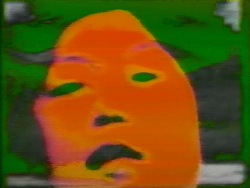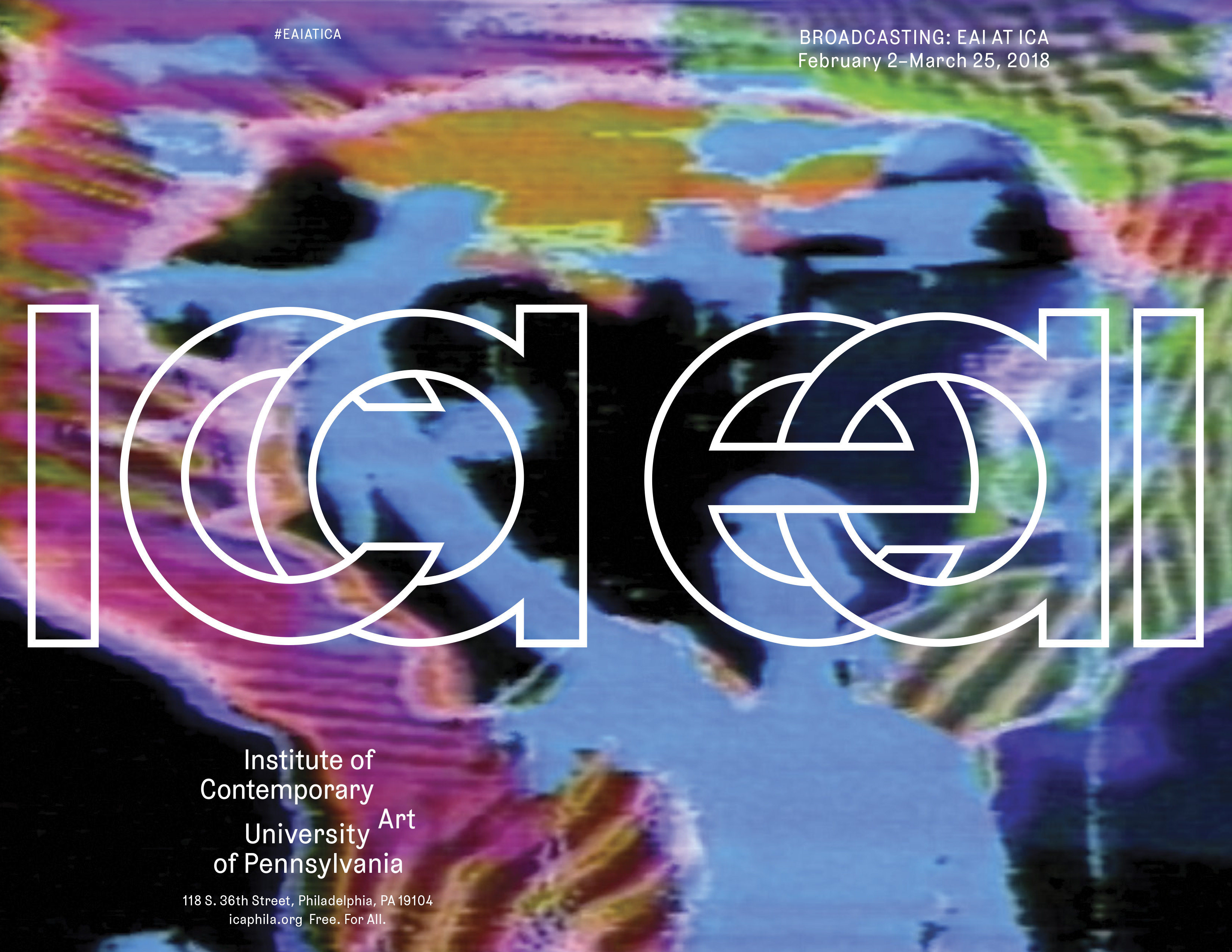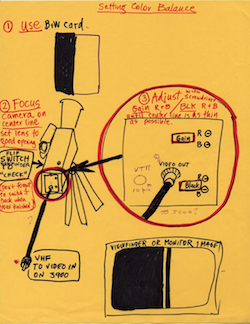Shigeko Kubota
Related EAI Public Programs
"Broadcasting: EAI at ICA"
Institute of Contemporary Art 118 S. 36th Street
Philadelphia, PA 19104
February 2nd–March 25th, 2018
With additional programs at Lightbox Film Center, PhillyCAM, Scribe Video Center, Slought, Anthology Film Archives, EAI, and EMPAC.
Electronic Arts Intermix (EAI) is pleased to co-present Broadcasting: EAI at ICA at the Institute of Contemporary Art (ICA), Philadelphia, February 2nd through March 25th. Featuring works by artists including Robert Beck, Dara Birnbaum, Tony Cokes, Ulysses Jenkins, JODI, Shigeko Kubota, Kristin Lucas, Shana Moulton, Trevor Shimizu, and TVTV, the exhibition will focus on how artists exploit the act of broadcasting as a subject, as a means of intervention, and as a form of participation across a variety of displays.
The word “broadcast” originated as an agricultural term meaning to disperse seeds widely, but became a figurative description for communications technology in the radio age. In the television era, with which broadcasting is most synonymous, the introduction of personal video equipment fostered a more dynamic interpretation, facilitating a two-way flow of information that resonates with contemporary participatory media. In this spirit, the physical walls of the gallery will extend beyond ICA through a series of collaborations with Lightbox Film Center, PhillyCAM, Scribe Video Center, Slought, Anthology Film Archives, EAI, and EMPAC.
Broadcasting: EAI at ICA is co-curated by Alex Klein, Dorothy & Stephen R. Weber (CHE’60) Curator, ICA and Rebecca Cleman, Director of Distribution, Electronic Arts Intermix (EAI)
Electronic Arts Intermix (EAI) is pleased to co-present Broadcasting: EAI at ICA at the Institute of Contemporary Art (ICA), Philadelphia, February 2nd through March 25th. Featuring works by artists including Robert Beck, Dara Birnbaum, Tony Cokes, Ulysses Jenkins, JODI, Shigeko Kubota, Kristin Lucas, Shana Moulton, Trevor Shimizu, and TVTV, the exhibition will focus on how artists exploit the act of broadcasting as a subject, as a means of intervention, and as a form of participation across a variety of displays.
The word “broadcast” originated as an agricultural term meaning to disperse seeds widely, but became a figurative description for communications technology in the radio age. In the television era, with which broadcasting is most synonymous, the introduction of personal video equipment fostered a more dynamic interpretation, facilitating a two-way flow of information that resonates with contemporary participatory media. In this spirit, the physical walls of the gallery will extend beyond ICA through a series of collaborations with Lightbox Film Center, PhillyCAM, Scribe Video Center, Slought, Anthology Film Archives, EAI, and EMPAC.
Broadcasting: EAI at ICA is co-curated by Alex Klein, Dorothy & Stephen R. Weber (CHE’60) Curator, ICA and Rebecca Cleman, Director of Distribution, Electronic Arts Intermix (EAI)
"Edited at EAI": 45th Anniversary Series
Electronic Arts Intermix (EAI) 535 West 22nd St. 5th Fl.
New York, NY 10011
April–September, 2016
April 27: "Edited at EAI": 1972-77
June 16: "Edited at EAI": Artist to Artist
June 22: "Edited at EAI": Videos by Tom Rubnitz
July 27: "Edited at EAI": Restless Generation
Aug 16: "Edited at EAI": Video Interference
Sept 22: "Edited at EAI": Dara Birnbaum
As part of EAI's ongoing 45th anniversary celebrations, we launched a series of screenings that highlight a less well-known but historically important and creatively fertile area of our programs: EAI's Editing Facility for artists. Established in 1972 with early 1/2" open reel editing equipment, EAI's facility was one of the first such post-production workspaces for artists in the U.S. Over five decades, an extraordinary group of artists has used EAI's facility to create some of the most significant works in media art's diverse histories. Many of these artists and works will be featured in screenings throughout our 45th anniversary year.
The first screening on April 27, "Edited at EAI": 1972-77 featured an eclectic selection of works from the 1970s, charted the alternative artistic, political, and cultural expressions of artists experimenting with emergent video editing technologies and strategies. The program included early works from the 1970s by Ant Farm, Juan Downey, Jean Dupuy, Shigeko Kubota, Mary Lucier, Raindance, Anthony Ramos, Ira Schneider, and Hannah Wilke, among others.
On June 16 Artist to Artist featured the rich collaborative process and the creative relationships between artists and the artists/editors with whom they worked, through the lens of EAI's editing facility. Video works by Cheryl Donegan, Ursula Hodel, Nam June Paik, Carolee Schneemann, and Michael Smith—all edited at EAI—were shown together with works by Robert Beck, Seth Price and Trevor Shimizu, three internationally recognized artists who spent formative years as EAI editors. Artists Robert Buck and Cheryl Donegan were in conversation following the screening.
On June 22 EAI celebrated the video work of Tom Rubnitz (1956-1992), whose deliriously camp genre parodies and music videos capture the anarchic spirit and talents of the 1980s East Village scene of Club 57 and the Pyramid Club. The rich body of work that Rubnitz edited at EAI includes TV spoofs, music videos, and the musical parody Psykho III The Musical (1985). Artist John Kelly participated in a conversation following the screening.
On July 27 Restless Generation focused on a group of conceptually driven performance videos by women artists who reenergized and redefined the genre in the 1990s, as seen through the lens of EAI's editing facility. These lo-fi performances staged for the camera—by artists such as Vanessa Beecroft, Alix Lambert, Kirsten Mosher, Alix Pearlstein, and Beverly Semmes, among others—evoke the strategies of the first generation of artists working with video in the early 1970s, even as their bold stylizations, ironic sensibility, and explicit nods to consumer culture announced a fresh approach to representations of female identity and the body that spoke emphatically to its time.
On August 16 the series continued with an evening of activist video work from the late 1980s through the mid-1990s. Shot largely on low-end consumer equipment and edited, often off-hours, at EAI, these works use video as an activist tool, confronting urgent issues around the AIDS crisis, race, gender, and sexuality. Videos by ACT UP affinity groups DIVA TV (Damned Interfering Video Activist Television) and House of Color, as well as art collective X-PRZ, were screened along with work by artists Robert Beck and Tom Kalin. Although rooted in the specific political and cultural contexts of that moment, these powerful activist voices
June 16: "Edited at EAI": Artist to Artist
June 22: "Edited at EAI": Videos by Tom Rubnitz
July 27: "Edited at EAI": Restless Generation
Aug 16: "Edited at EAI": Video Interference
Sept 22: "Edited at EAI": Dara Birnbaum
As part of EAI's ongoing 45th anniversary celebrations, we launched a series of screenings that highlight a less well-known but historically important and creatively fertile area of our programs: EAI's Editing Facility for artists. Established in 1972 with early 1/2" open reel editing equipment, EAI's facility was one of the first such post-production workspaces for artists in the U.S. Over five decades, an extraordinary group of artists has used EAI's facility to create some of the most significant works in media art's diverse histories. Many of these artists and works will be featured in screenings throughout our 45th anniversary year.
The first screening on April 27, "Edited at EAI": 1972-77 featured an eclectic selection of works from the 1970s, charted the alternative artistic, political, and cultural expressions of artists experimenting with emergent video editing technologies and strategies. The program included early works from the 1970s by Ant Farm, Juan Downey, Jean Dupuy, Shigeko Kubota, Mary Lucier, Raindance, Anthony Ramos, Ira Schneider, and Hannah Wilke, among others.
On June 16 Artist to Artist featured the rich collaborative process and the creative relationships between artists and the artists/editors with whom they worked, through the lens of EAI's editing facility. Video works by Cheryl Donegan, Ursula Hodel, Nam June Paik, Carolee Schneemann, and Michael Smith—all edited at EAI—were shown together with works by Robert Beck, Seth Price and Trevor Shimizu, three internationally recognized artists who spent formative years as EAI editors. Artists Robert Buck and Cheryl Donegan were in conversation following the screening.
On June 22 EAI celebrated the video work of Tom Rubnitz (1956-1992), whose deliriously camp genre parodies and music videos capture the anarchic spirit and talents of the 1980s East Village scene of Club 57 and the Pyramid Club. The rich body of work that Rubnitz edited at EAI includes TV spoofs, music videos, and the musical parody Psykho III The Musical (1985). Artist John Kelly participated in a conversation following the screening.
On July 27 Restless Generation focused on a group of conceptually driven performance videos by women artists who reenergized and redefined the genre in the 1990s, as seen through the lens of EAI's editing facility. These lo-fi performances staged for the camera—by artists such as Vanessa Beecroft, Alix Lambert, Kirsten Mosher, Alix Pearlstein, and Beverly Semmes, among others—evoke the strategies of the first generation of artists working with video in the early 1970s, even as their bold stylizations, ironic sensibility, and explicit nods to consumer culture announced a fresh approach to representations of female identity and the body that spoke emphatically to its time.
On August 16 the series continued with an evening of activist video work from the late 1980s through the mid-1990s. Shot largely on low-end consumer equipment and edited, often off-hours, at EAI, these works use video as an activist tool, confronting urgent issues around the AIDS crisis, race, gender, and sexuality. Videos by ACT UP affinity groups DIVA TV (Damned Interfering Video Activist Television) and House of Color, as well as art collective X-PRZ, were screened along with work by artists Robert Beck and Tom Kalin. Although rooted in the specific political and cultural contexts of that moment, these powerful activist voices
"Edited at EAI": 1972-77
Electronic Arts Intermix (EAI) 535 W. 22nd St. 5th Floor
New York, NY 10011
Wednesday, April 27, 2016
Noon - 8pm
As part of EAI's ongoing 45th anniversary celebrations, we launched a series of screenings that highlight an under-recognized but historically important and creatively fertile area of our programs: EAI's Editing Facility for artists. Established in 1972 with early 1/2" open reel editing equipment, EAI's facility was one of the first such post-production workspaces for artists in the U.S. Over five decades, an extraordinary group of artists has used EAI's facility to create some of the most significant works in media art's diverse histories. The first screening, which featured an eclectic selection of works from the 1970s, charted the alternative artistic, political, and cultural expressions of artists experimenting with emergent video editing technologies and strategies.
SHIGEKO KUBOTA: Daylong Tribute Screening at EAI
Electronic Arts Intermix (EAI) 535 W. 22nd St. 5th Floor
New York, NY 10011
Wednesday, September 9, 2015
11:00 am - 8:15 pm
Admission Free
EAI paid tribute to Shigeko Kubota (1937-2015) with a daylong screening of her remarkable video works. The program, which spanned a period of thirty-five years, included Kubota's seminal "Broken Diary" pieces, such as Europe on ½" a Day (1972) and My Father (1973-75), as well as documents of her multi-media installations (1970-94), and videos such as Rock Video: Cherry Blossom (1986), in which she fuses nature and electronic processing. Honoring Kubota's life and art through a daylong immersion in her groundbreaking video works, the program screened at multiple scheduled times throughout the day, and was free and open to the public.
High Line Art & EAI Present: SHIGEKO KUBOTA
ROCK VIDEO: CHERRY BLOSSOM
The High Line High Line Channel 22
Seating Steps on the High Line
at West 22nd Street
March 13 - April 20, 2014
Spring came to the High Line in the exuberant form of Shigeko Kubota's iconic video work, Rock Video: Cherry Blossom (1986). EAI was pleased to collaborate with High Line Art, a program of Friends of the High Line, to present Kubota's silent video on High Line Channel 22. This outdoor screening, projected on a building to the east of the High Line at West 22nd Street, was visible from the park's Seating Steps as well as from the sidewalk below. Rock Video: Cherry Blossom was on view daily from Thursday, March 13 through Monday, April 20, 2014 from 6:00 to 11:00 PM.
EAI IN TIMES SQUARE:
40 Years of Video Art
MTV 44½ Screen Times Square
Broadway between 44th and 45th Streets
New York, NY 10036
April 13 - 19, 2011
Noon - 4pm and 6pm - 11pm
at the top of every hour
Saturday, April 16 & Sunday, April 17
Full program also plays at noon
Electronic Arts Intermix (EAI) celebrated its 40th anniversary with a special project for Times Square. In partnership with the Times Square Alliance and MTV, EAI brought artists' visions to the MTV 44½ LED Screen. Marking EAI's 40 years of support for moving image art, EAI in Times Square celebrated video art's rich history of creative intervention in one of the world's most dynamic media landscapes.
From April 13 to 19, EAI highlighted the remarkable creative media interventions of artists on a spectacular scale. Works by Vito Acconci, Dan Asher, Phyllis Baldino, Dara Birnbaum, Gary Hill, Shigeko Kubota, Takeshi Murata, Nam June Paik, Martha Rosler, Stuart Sherman and William Wegman were seen daily on MTV 44½'s large-format LED screen.
From April 13 to 19, EAI highlighted the remarkable creative media interventions of artists on a spectacular scale. Works by Vito Acconci, Dan Asher, Phyllis Baldino, Dara Birnbaum, Gary Hill, Shigeko Kubota, Takeshi Murata, Nam June Paik, Martha Rosler, Stuart Sherman and William Wegman were seen daily on MTV 44½'s large-format LED screen.
SHIGEKO KUBOTA
EARLY VIDEO WORKS
EAI Video Project Space
X Initiative 548 West 22nd Street, Ground Floor
New York, NY 10011
October 7-17, 2009
Wednesday - Sunday, 11 am - 6 pm
EAI presented a program of early video works from the 1970s by Shigeko Kubota. A prominent Fluxus artist in the 1960s, Kubota's body of work includes video sculptures, installations and single-channel videos. In her earliest works, she developed an idiosyncratic video style that blurs the boundaries between personal diary and art-historical homage, often layering vibrant electronic processing techniques over everyday images.
Marcel Duchamp and John Cage (1972) is part elegy, part documentary, combining Kubota's own photos of the famous ìmusicalî chess match between the artist and composer with abstract image processing and compositions by Cage. Europe on 1/2 Inch a Day (1972) is an informal travelogue inspired by budget guidebooks. Armed with her Portapak (and half-inch videotape), Kubota presents an alternative tour of Amsterdam, Brussels, and Paris: underground performances, topical graffiti and a visit to Marcel Duchamp's grave. Video Girls and Video Songs for Navajo Sky (1973) is a surreal and surprisingly funny diary of the artist's month-long sojourn with a Navajo family on a reservation in Chinle, Arizona.
Marcel Duchamp and John Cage (1972) is part elegy, part documentary, combining Kubota's own photos of the famous ìmusicalî chess match between the artist and composer with abstract image processing and compositions by Cage. Europe on 1/2 Inch a Day (1972) is an informal travelogue inspired by budget guidebooks. Armed with her Portapak (and half-inch videotape), Kubota presents an alternative tour of Amsterdam, Brussels, and Paris: underground performances, topical graffiti and a visit to Marcel Duchamp's grave. Video Girls and Video Songs for Navajo Sky (1973) is a surreal and surprisingly funny diary of the artist's month-long sojourn with a Navajo family on a reservation in Chinle, Arizona.
MERCE CUNNINGHAM
Video Tribute
EAI Video Project Space
X Initiative 548 West 22nd Street, Ground Floor
New York, NY 10011
August 18-21, 2009
Merce by Merce by Paik is a two-part tribute to visionary choreographer Merce Cunningham. Blue Studio: Five Segments is a stunning work of videodance by Cunningham and his then filmmaker-in-residence, artist Charles Atlas, one of the premier interpreters of dance, theater and performance on video.
In Merce and Marcel, Nam June Paik and Shigeko Kubota create a densely textured, transcultural collage that pays tribute to the eponymous artists. In a witty temporal layering that Paik terms a "dance of time," rare interviews with Cunningham and Marcel Duchamp by Russell Connor are intercut and superimposed.
EAI & Y-3 PRESENT ART IN MOTION
Public Video Art Screenings in Miami's Design District
Y-3 Miami 150 NE 40th Street, Design District, Miami, Florida
December 5 - 8, 2007. Closing Reception: Saturday, December 8, 8 - 10 pm
EAI partnered with Y-3 to present a program of video works from the EAI collection on the exterior of Y-3's newly opened location in Miami's Design District. Inside the Y-3 store, in its second level event space, an indoor video program featuring the influential and provocative video works of Dara Birnbaum was on view.
THE MEMORY OF TEMPTATIONS
ediciónmadrid Madrid, Spain
October 23-27, 2002
On the occasion of ediciónmadrid, EAI was pleased to present a selection of titles from the late 1960s and the 1970s. These early works represent the diverse art-making strategies of the time including body-based performance tapes, conceptual exercises, the video journal, and early image processing. Presented in three programs, works by Bruce Nauman, Marina Abramovic, Vito Acconci, Shigeko Kubota, John Baldessari, Gordon Matta-Clark, and Nam June Paik will be featured.
FIRST DECADE: VIDEO FROM THE EAI ARCHIVES
Museum of Modern Art New York City
February 26 - April 30, 2002
As the keystone of EAI's 30th anniversary events, Museum of Modern Art presented First Decade: Video from the EAI Archives, a major retrospective that looked at the early days of video through EAI's historical collection. Featuring 60 works, the twelve-part program explored themes and issues ranging from performance and the body; narrative; cultural essays; activism, and poetics.










